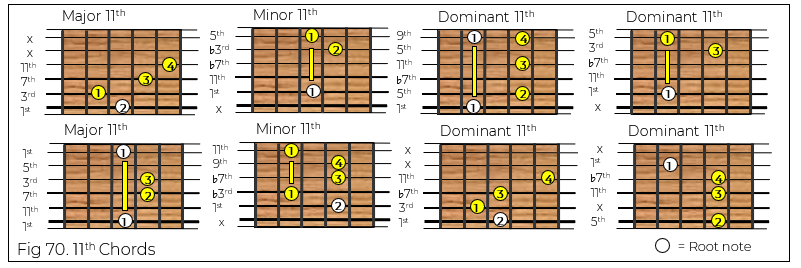Extended chords are basic major 7, minor 7 or dominant 7 chords which have other notes added to create a more colourful sound.
If we keep stacking thirds onto our 7 chords, we end up with some more notes to include in the chord. These notes are the 9th‘s, 11th‘s and 13th‘s.
NINTH CHORDS
9th chords will add the 2nd note of the scale to the triad, one octave higher (see ‘Intervals‘). They contain the 7th as well. They can be major, minor or dominant.

Listen (root notes on 5th fret):
ELEVENTH CHORDS
The following musical example shows the basic use of an open D (major) 6 chord alternating with a s11th chords will add the 4th note of the scale to the triad, one octave higher (see ‘Intervals‘). They contain the 7th and sometimes the 9th as well. They can be major, minor or dominant (usually dominant).

Listen (root notes on 5th fret):
THIRTEENTH CHORDS
13th chords will add the 6th note of the scale to the triad, one octave higher (see ‘Intervals‘). They contain the 7th, 9th and 11th as well, however the 5th, 9th and 11th notes are often omitted, since there will be too many notes to finger. They can be major, minor or dominant (usually dominant).

Listen (root notes on 5th Fret):
These chords are used as embellishments to the standard major, minor and dominant chords, and can be substituted in place of these standard triads provided they are in the same mode. That is, a major extension can only occur on a major chord, a minor extension can only occur on a minor chord, and a dominant extension can only occur on a dominant chord.